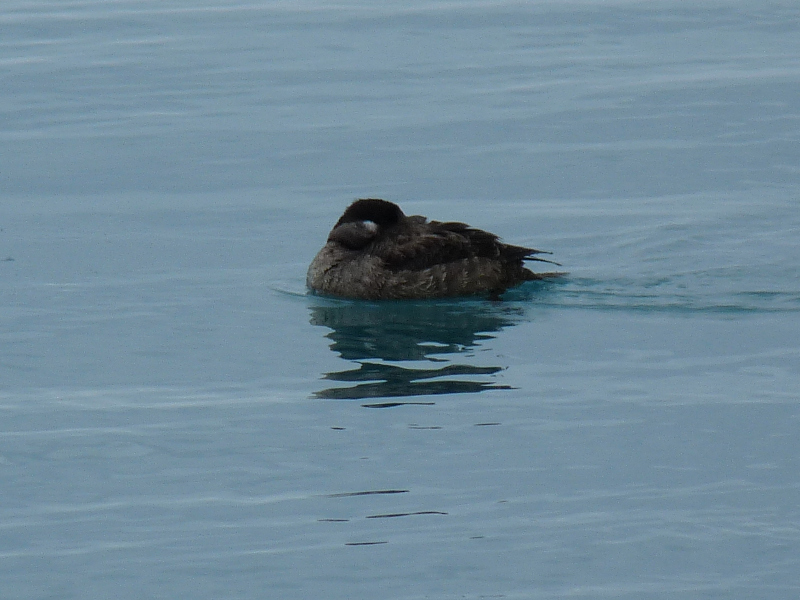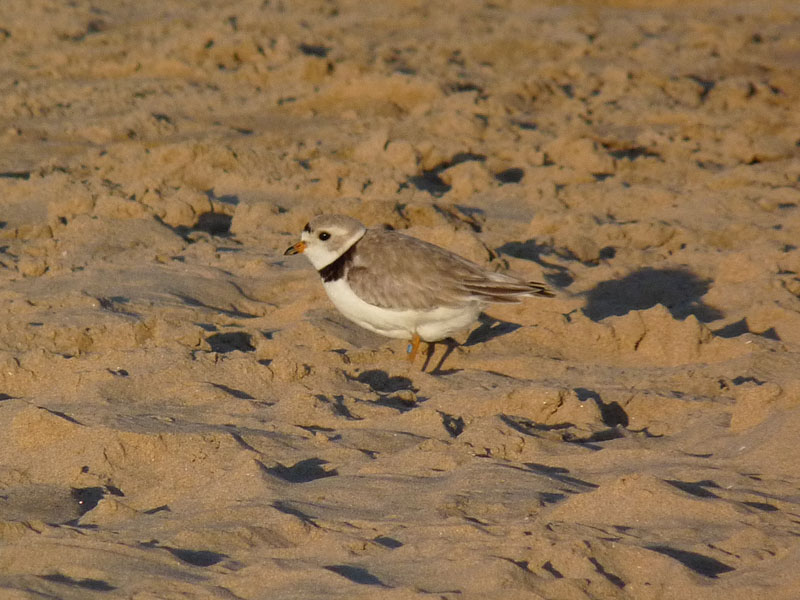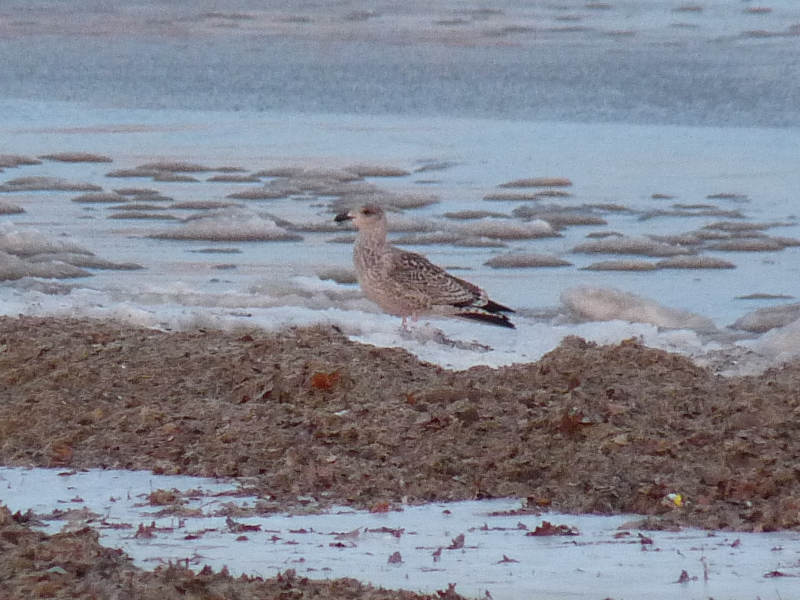A male Red-winged Blackbird surprised me on February 15. It seems a little early for them, but Red-wingeds didn’t (and usually don’t) winter at Montrose, so this bird has to be a migrant. Along with Red-wings, other early spring passerine migrants we should start seeing in the next couple weeks include Horned Larks, Song Sparrows, and Eastern Meadowlarks. Waterfowl diversity will also pick up during this period. Check weather reports for warm fronts and south winds as these are the conditions that bring in spring migrants.
First of Season White-winged Scoters, February 9, 2022
Chicago area birder David Johnson likes to point out that February is a good month for White-winged Scoters on Lake Michigan. Indeed, the first White-winged Scoters we see at Montrose show up in February. On February 9, a group of three White-wingeds flew north past the Point, the first report of this species at Montrose in 2022. The best way to look for White-winged Scoters at Montrose is to spend time along the immediate lakefront, scanning Lake Michigan for waterfowl on the lake or flying by. Flocks of 20 or more birds are seen on occasion. White-wingeds can also turn up at or just outside the harbor mouth.
Surf Scoter, February 7, 2022
Terry Walsh found a tame female Surf Scoter at the harbor mouth on February 7. Surf Scoters are rare winter visitors to the Chicago lakefront in winter. This bird brightened what was otherwise an unremarkable morning of birding in a usually uneventful month. February isn’t much different than January in terms of avian variety, though towards the end of the month we can start seeing early migrants, especially if we get a warmup. Link to my eBird checklist below.
Tip: Don’t forget to check the harbor mouth when birding Montrose. Waterfowl and grebes can be hidden from view if you only scan the east, south, or north sides of the harbor. To do this, park at the west end of the harbor near the turnaround and walk over to the harbor mouth.
eBird Checklist
February 7, 2022
Montrose Piping Plovers – Are They Worth It?
For the third consecutive year, Monty and Rose, our famous Piping Plover couple, nested and raised a family. This is an enormous conservation success story by any measure, the first time Piping Plovers have nested in Chicago in over 50 years.
The wide sandy beach at Montrose is near perfect Piping Plover habitat, but Montrose is far from ideal as a nesting location. Montrose is one of the most popular beaches in Chicago; all that human activity makes life difficult for any bird that nests on the open beach, like Piping Plovers do. The human animals aren’t the only challenge the plovers face. Montrose is also home to several mammalian predators, including Striped Skunks and Racoons, and they aren’t above preying on Piping Plover eggs. In fact, in 2021, a skunk ate some of the eggs from Monty and Rose’s first clutch. As if the mammalian predators weren’t enough, Montrose also hosts Peregrine Falcons, Cooper’s Hawks, Great Blue Herons, and gulls, all capable of dispatching the plovers and their young. With all these threats it’s a miracle Monty and Rose are able to nest and raise a family. The hard truth is that without human involvement the chances of them nesting successfully are small. Part of the beach got fenced off to keep people out in case Monty and Rose decided to nest there in 2021. Like the beach, the Dunes got fenced off to keep people out when Monty and Rose chose to nest there. To protect the eggs form predators, a steel cage was placed over the nest. Even with a cage a determined skunk managed to slip through and pilfer the eggs, forcing Monty and Rose to start over. A new, larger cage prevented this from happening again. To deter avian predators, biologists stationed a trap baited with a live pigeon in the Dunes. On top of all this, a cadre of dedicated volunteers spent hundreds of hours monitoring the plovers.
So the question is, is all this effort worth it? Is all the inconvenience worth it? I led field trips to Montrose in the spring of 2021 and I would take my guests down to the beach and Dunes, where I talked about the nesting Piping Plovers and the efforts to protect them. On one trip a client remarked “All this for a couple little birds?” It’s a legitimate question to ask. I think the answer is a resounding yes. Monty and Rose became celebrities in Chicago, raising awareness of their struggle and the plight of Piping Plovers on the Great Lakes. Their story was mentioned in the news and it became impossible not to sympathize with them. Their story also raised awareness of Montrose and how important it is for wildlife, especially the fragile Dunes.
The story of Monty and Rose is a story of hope and struggle, of people from different backgrounds working together to give a pair of underdogs a fighting chance at raising their kids in a not always hospitable environment. We look forward to their return.
2022 Winter Birding Tips
Winter is the slow season at Montrose. You’d be doing well if you saw 20 species in a morning. As such, there are some things to do and birds to look for.
- This is shaping up to be a good winter for Snowy Owls. As of mid January, many have been reported in the Chicago area, and several have been seen at Montrose. The best places to check for Snowies are the beach and Dunes and on the fishing pier, especially after it ices over. Note: Be careful as the paths and sidewalks can be covered in ice. This is especially true of the fishing pier. Sometimes this ice is thin and not easy to see, so-called black ice.
- The fruiting trees are hosting numbers of American Robins and Northern Cardinals. That’s probably all you will see but there’s always a chance a more unusual frugivore will show up, like a Townsend’s Solitaire or Varied Thrush.
- The open waters of Lake Michigan and the harbor are attracting numbers of ducks, mainly Red-breasted and Common Mergansers and Common Goldeneyes, but as long as the water remains open, an unusual duck, loon, or grebe is possible. Don’t forget to check the harbor mouth too.
- Common Redpolls are showing up in big numbers in northeastern Illinois, and several have been seen at Montrose. Good places to look for them are weedy areas, like the Native Planting Area along the southeast corner of the Point.
As always, don’t forget to check the Montrose Point eBird Hotspot for current sightings.
Great Black-backed Gulls
One of the more unusual birds we’ve been seeing this winter are Great Black-backed Gulls. An adult and first cycle bird have been hanging around the beach and nearby Lake Michigan since late 2021. On January 4 I saw the young bird loafing on the public beach (gulls will gather on the beach to look for and eat washed up salmon). Great Black-backed Gulls are uncommon but regular in small numbers in the Chicago area in winter. Ducks and gulls are about the only birding game in town now that serious winter cold has set in.
What’s In a Name?
Lots of birds have alternate or colloquial names, like Big Cranky for Great Blue Heron or Camp Robber for Canada Jay. One colloquial name for Great Black-backed Gull is Coffin Carrier, an allusion to the dark back of adults. Some person, somewhere, came up with this name and it caught on, becoming part of the language and culture of a region. Colloquial names often have color or personality in a way that the standard English names don’t. The name Great Black-backed Gull is literal and descriptive, but Coffin Carrier has a different connotation and shows imagination and creative thinking. Maybe an undertaker in Boston came up with the name.




